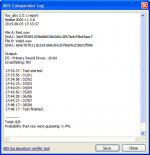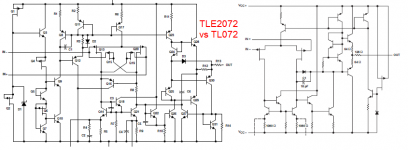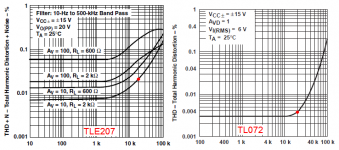TL071 sounds plain distorted, as is to be expected with 390R load.
390R is not a normal/realistic load for pretty much any usual opamp, and renders this listening test another useless waste of time.
I suggest a rerun with build out resistance (100R ?) and say 2K+ load to more accurately represent real world conditions.
The result of this test is that 5534 and 833 sound relatively clean but different, the other opamps don't cut it with 390R load.
Dan.
It should be easy enough.
Yes, maybe the thread has run it course, but it has been very informative and a fun learning experience. I am grateful for the time and effort you put into making this work.
What I take away from it is that on speakers, I could not differentiate between any of the op amps, but on a pair of Stax headphone I could, barely. Since 5 op amps in series is about what happens in the active crossovers I make, this is relevant information to me. By using a solid and affordable performer like the NE5532, you can't go wrong.
Oh, wait, we have not yet finished learning!!!
Max Headroom informed us that he could hear pronounced differences between the different op amps, and so you put together the test again, with some improvements. We haven't heard from him since. The question if some people can really differentiate between op amps, is even more relevant to me than if I can do so. I don't make my speakers to keep them to myself.
This being said, great thread and thanks again.
Thanks. These kind of tests are time consuming to set up and so its good to know they are appreciated.
I wasn't able to make time to listen to the files as planned over the weekend, sorry about that.
I will endeavor to run the test in the next couple of days and give subjective opinion of what I find.
Dan.
No rush 🙂
on speakers, I could not differentiate between any of the op amps, but on a pair of Stax headphone I could,
<snip>
I don't make my speakers to keep them to myself.
Your STAX is too good for your speaker 😀 Seriously, I usually rely on my speaker more than my Sennheiser, but in this test my newer speaker just couldn't do it better than the headphone so I modified the speaker. Haven't tried it again with the modified speaker but I think I know why the speakers lost its "ears".
By using a solid and affordable performer like the NE5532, you can't go wrong.
Why not. I think nowadays opamp chips are not expensive so why choosing affordable chip for the sake of price. Choose OPA2134 instead. Statistically this opamp satisfies more listeners than NE5532.
if some people can really differentiate between op amps, is even more relevant to me than if I can do so.
Start with Statistics, if in doubt.
For example, record a track twice with the same op-amps and see if they score the same in the rankings. Better still, do that with two or three of the opamps, then scatter them randomly. Make sure to erase or randomize the file time stamps, of course.
This is the right way to do it. I think (I should say I believe, or I'm sure, because I have done this) with such a controlled test I can pass the ABX quite satisfactorily with these opamps. But if you look at this carefully, there is no finite boundary between "can hear it" and "cannot hear it". I'm pretty sure that many can hear it, but their performance in ABX will be too bad for most of you to believe it.
These kind of tests are time consuming to set up and so its good to know they are appreciated.
Many will appreciate it (well, I for sure learn a lot from every test). If not today, it could be later, as this information stays in the website.
First off, thanks to Mooly for setting it up and providing the results. It's good fun, and a useful discussion.
If anything, the conclusion you can take home is that op amps are pretty hardy beasts, and will perform quite well under the grimmest conditions. I suggest you should probably leave it there.
Let's try an analogy: would you evaluate a 300B SET amp tied to a 3 ohm, 60 dB/W speakers? I mean, you would certainly be able to "hear" the amp under those conditions, but only because you have made it scream.
To the extent that op amps "sound" of anything, it depends on their application and environment. If you want to use an op amp as a unity gain buffer while driving <500 ohm loads, then these results are relevant to your interests. At different source impedance, different loading, and different gain settings, and even different power supplies, each of these op amps is likely to sound (and perform) differently and this test is not indicative of that performance in any way.
There's no magic here. Even at the most basic level of output noise and distortion, it's a textbook exercise to show how these quantities vary with input impedance and load, respectively.
Know your application and read the datasheets carefully. That's how you select op amps.
If anything, the conclusion you can take home is that op amps are pretty hardy beasts, and will perform quite well under the grimmest conditions. I suggest you should probably leave it there.
Let's try an analogy: would you evaluate a 300B SET amp tied to a 3 ohm, 60 dB/W speakers? I mean, you would certainly be able to "hear" the amp under those conditions, but only because you have made it scream.
To the extent that op amps "sound" of anything, it depends on their application and environment. If you want to use an op amp as a unity gain buffer while driving <500 ohm loads, then these results are relevant to your interests. At different source impedance, different loading, and different gain settings, and even different power supplies, each of these op amps is likely to sound (and perform) differently and this test is not indicative of that performance in any way.
There's no magic here. Even at the most basic level of output noise and distortion, it's a textbook exercise to show how these quantities vary with input impedance and load, respectively.
Know your application and read the datasheets carefully. That's how you select op amps.
Last edited:
Husky Voice
Here are 2 opamps (red and violet). One of the opamp produce the very husky voice of Mark Knopfler on the "You walk out on a high wire", while the other one just too lean. No matter how you change the amplitude or add various controls to the test, you cannot change the tonality.
Here are 2 opamps (red and violet). One of the opamp produce the very husky voice of Mark Knopfler on the "You walk out on a high wire", while the other one just too lean. No matter how you change the amplitude or add various controls to the test, you cannot change the tonality.
Attachments
Here are 2 opamps (red and violet). One of the opamp produce the very husky voice of Mark Knopfler on the "You walk out on a high wire", while the other one just too lean. No matter how you change the amplitude or add various controls to the test, you cannot change the tonality.
WTF !.Total: 8/8
Probability that you were guessing: 0.4%
Anything say 6/8 or better means that you are picking up fine differences......concentration span/boredom etc factors into the equation/results.
10/10 or 8/8 means an unequivocal result in my view.
The importance of the sonic differences to the average listener is another subject altogether...hell, I do very much of my listening to spoken word AM radio but even with such a source I can easily tell differences between transmitters relaying the same content.
With such AM sources I can also easily hear differences wrought by the likes of BQP.....don't shoot the messenger please.
Dan.
At different source impedance, different loading, and different gain settings, and even different power supplies, each of these op amps is likely to sound (and perform) differently and this test is not indicative of that performance in any way.
No matter how you change the amplitude or add various controls to the test, you cannot change the tonality.
Create another circuit. An easy one. A normal buffer with 10k load impedance. Same music. I have a strong feeling that RED will sound like RED and VIOLET will sound like VIOLET.
Just mod the existing circuit with such values....I believe I suggested this already.Create another circuit. An easy one. A normal buffer with 10k load impedance. Same music. I have a strong feeling that RED will sound like RED and VIOLET will sound like VIOLET.
And yes I expect similar/same outcome but likely a little harder to pick the differences/sonic flavors but they should still be evident.
Dan.
Last edited:
First off, thanks to Mooly for setting it up and providing the results. It's good fun, and a useful discussion.
Thanks. Good to know you are enjoying these.
Here are 2 opamps (red and violet). One of the opamp produce the very husky voice of Mark Knopfler on the "You walk out on a high wire", while the other one just too lean. No matter how you change the amplitude or add various controls to the test, you cannot change the tonality.
Which do you prefer of those two ?
Which do you prefer of those two ?
Of course I prefer RED to all the other opamps 😀
That's, erm, interesting.
I'll wait for Dan to say whether he wants to listen again before revealing.
I'll wait for Dan to say whether he wants to listen again before revealing.
Anything say 6/8 or better means that you are picking up fine differences......concentration span/boredom etc factors into the equation/results.
10/10 or 8/8 means an unequivocal result in my view.
I just came home from work in a very tired condition. When I listened the husky vocal in training mode I made no mistake. I did it several time (with no mistake, more than 10x for sure) until I was sure that I will not make mistake in the test mode. Then I hit the "Begin Test" button and that's the result.
You are correct about the 6/8.
Before this thread fades into oblivion 😉 I better put the new key up. Thanks as always to those that did try these.
Master = Green
M/mega = Purple
JRC4560 = Yellow
LM833P = Blue
LM4562 = Orange
5532 = Indigo
TL072 = Red
TLE2072 = Violet
The TL072 'ain't so bad after all, eh Jay !
Master = Green
M/mega = Purple
JRC4560 = Yellow
LM833P = Blue
LM4562 = Orange
5532 = Indigo
TL072 = Red
TLE2072 = Violet
The TL072 'ain't so bad after all, eh Jay !
TL072 = Red
TLE2072 = Violet
The TL072 'ain't so bad after all, eh Jay !
The reason I compared TL072 and TLE2072 was because I had a feeling that these 2 opamps had the biggest sound difference (in fact, I had no mistake in differentiating Mark Knopfler's husky voice either in ABX test mode or training mode). And because I have put TL072 on the top of my preference list and TLE2072 on the bottom of my preference list.
I'm a believer in amplifier topology and simplicity (see attachment).
Attachments
The TL072 'ain't so bad after all, eh Jay !
Not bad at all. After looking at the PDF, I actually believe in the quality of this chip more.
From my experience, and also from the listening tests (thanks Mooly), I found that the problem with sound has high correlation with an existence of undesirable distortion, and this undesirable distortion seems to correlate with high frequency, either intermodulation or very high order non-linear distortion.
CFB versus VFB for example, has trigerred a hot debate. But the fact is that everybody agree that CFB has better high frequency performance. It is just that less people realize how important the HF performance is.
NE5532 for example, if I'm not mistaken, has a not favorable THD above 6kHz. I think this could be the reason I found it fatiguing, while the general performance is outstanding. But then I will be happy to use NE5532 for bass duty, or before the AD conversion stage.
Here's TL072 superior THD at HF (see attachment). I believe NE5532 is not as good as this??
ADD:
The THD for TL072 is minus the noise (which is not so good), but the point is the non-linear distortion is flat up to 10kHz and more. Noise is not so disturbing imo, and to implement this chip I think the circuit should have a very good/low power supply noise.
Attachments
Last edited:
I failed the identifying characteristics test, as I picked Violet (TLE2072). In the first run I liked LM833P.
But thanks very much for the effort. 🙂
Regards.
But thanks very much for the effort. 🙂
Regards.
Jay, you read a different CFA debate than I did then
some don't think CFA brings any useful "magic" to audio frequency reproduction - a decade ago you couldn't mention CFA at diyAudio without a guru telling you he and his customers universally found it sucked for audio
I don't go that far - never really make such broad subjective claims - just examine the circuit theory, datasheets and compare with the smattering of Psychoacoustics I've picked up over the decades of hobby interest
but I do find the recent CFA enthusiasm here heavily fanboyish - not mature circuit analysis, over claiming credit for circuit techniques that are not CFA specific, vilifying people trying to simply bring balance and perspective to the discussion
I have made really excellent technical performing composite amps with TL072 input (a least for cheap prototyping, debugging) and several different full complementary bipolar semi process modern monolithic VFA as well as CFA buffer/output amp stages
some don't think CFA brings any useful "magic" to audio frequency reproduction - a decade ago you couldn't mention CFA at diyAudio without a guru telling you he and his customers universally found it sucked for audio
I don't go that far - never really make such broad subjective claims - just examine the circuit theory, datasheets and compare with the smattering of Psychoacoustics I've picked up over the decades of hobby interest
but I do find the recent CFA enthusiasm here heavily fanboyish - not mature circuit analysis, over claiming credit for circuit techniques that are not CFA specific, vilifying people trying to simply bring balance and perspective to the discussion
I have made really excellent technical performing composite amps with TL072 input (a least for cheap prototyping, debugging) and several different full complementary bipolar semi process modern monolithic VFA as well as CFA buffer/output amp stages
Last edited:
Re-use of same files makes direct comparison and analysis possible without listening. We all know what this leads too.....
Yep, exactly the sort of stuff expected.
Mooly,
I think a complete rewind and reset is in order with new recordings. Otherwise Jay's fantastic comments are worthless.
- Status
- Not open for further replies.
- Home
- General Interest
- Everything Else
- Listening Test. Trying to understand what we think we hear.


